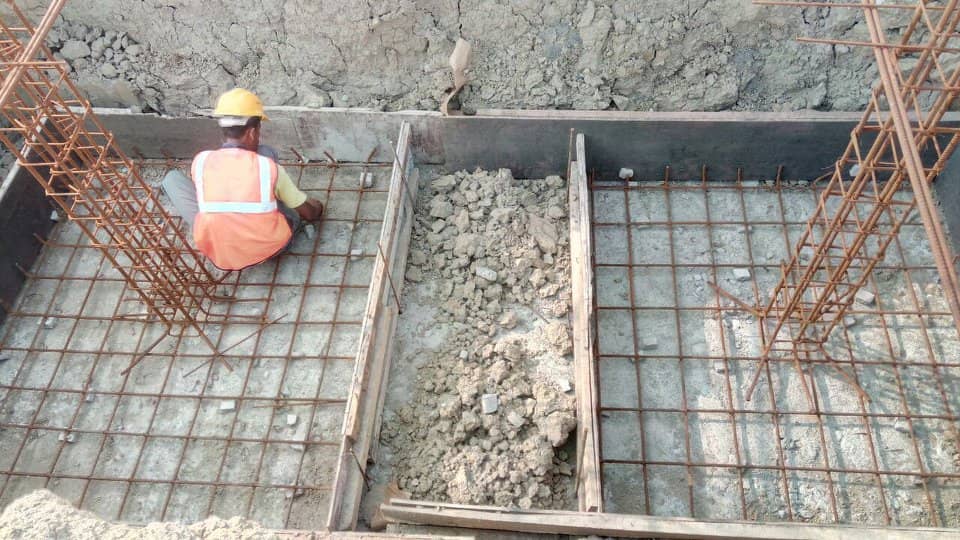What is Footing?
In this article, we are going to discuss Strap Footing – Its Types, Advantages & Disadvantages.
Basically, Footing is a component of the foundation of any building that is base and helps distribute the weight of the entire building equally and ensures stability. The purpose of footing is to transfer a load of building to the soil it is constructed on. Relying upon the aim, purpose, quality, and weight-bearing capability of the footing they are divided into several types. Different types are used for construction purposes they are suitable.
- Slope footing
- Isolated Footing
- Strap Footing
- Strip Footing
- Stepped Footing
- Compound Footing
- Raft Footing
- Pile Footing
- Continuous Wall Footing
Also Read: Types Of Foundation & Their Uses In Building Construction
Compound Footing
Compound footing has more than one column. It is used only when you are left with no other option. Mostly it is used when the soil has less load-bearing capability than required. In compound footing distance of the column from the edge is sufficient
Compound footing is further divided into 3 types.
- Rectangular
- Trapezoid
- Tee- Shaped
When columns are close to one another compound footing is given preference but when the situation is opposite and has a large distance between columns strap footing is considered.
Strap Footing
Strap footing is a unique kind of compound footing with some additional parameters. In the case of strap footing distance of the column from the edge is very small that it might need extra excavation. So, this footing is prioritized when we have limited space for foundation so, instead of separate footings, they are associated with a solid concrete bar. This connecting bar or beam is called strap beam or strap footing. It is utilized to help disperse the heaviness of either intensely or whimsically stacked segment footings to nearby footings. The objective is to have a uniform bearing pressing factor and to limit differential settlement between sections.
A strap footing is built between the outside balance and the nearby inside balance the reason for the strap is to limit the toppling power because of the eccentric burden on the outside balance.
The base regions of the footings are proportioned so the bearing pressing factors are uniform and equivalent under the two bases. In this manner, it is fundamental that the resultant of the heaps on the two footings should go through the centroid of the territories of the two bases. The strap beam between the footings should not bear against the soil, henceforward the ground straightforwardly beneath the beam needs to be free and left uncompacted.
Before strap footing, many aspects are required to be studied and are listed below.
- Soil pressure under strap footing
- Shear Calculation
- Longitudinal Stresses
- Momentum
- Distribution of Forces
Advantages of Strap Footing
- It helps distribute load uniformly and transfer moment to the adjacent footing.
- It prevents the column from tilting.
- The employment of a strap footing may be excusable where the gap between columns is long and a regular combined footing is impractical due to the required massive excavation.
Disadvantages of Strap Footing
- Strap footing requires more concentration while it has been constructed because it has a difficult design.
- It can become more time-consuming comparatively as the calculation of pressure bearing, pressure distribution, moment, forces, and shears can become complex.
- It will demand expert workers for its construction.
Conclusion
In short, we should avoid using strap footing until conditions force us to do so. Under normal circumstances, we can go for other types of footings. When using strap footing in construction we should perform calculations keenly. Any miscalculation can lead to a massive loss like a tilting of the building.
| PROS | CONS |
|
|
Still, Do Have a Question? Ask a Question and Get an Instant Answer





A strap footing, also known as a combined footing, is a type of foundation used to support two or more columns that are closely spaced and have individual footings that overlap. It consists of a continuous strip of reinforced concrete that spans across the bases of the columns, connecting them together. Strap footings are commonly used in situations where individual footings would be too closely spaced or when the soil bearing capacity is inadequate for isolated footings. Here are the types, advantages, and disadvantages of strap footings:
Types of Strap Footings:
1. Wall Footing: This type of strap footing is used to support two parallel walls with columns at both ends. It acts as a continuous foundation for the walls and helps distribute the loads from the walls and columns efficiently.
2. Rectangular Strap Footing: A rectangular strap footing is used when the columns are arranged in a rectangular pattern. It connects the two adjacent pairs of columns to create a continuous foundation.
Advantages of Strap Footings:
1. Load Distribution: Strap footings distribute the loads from closely spaced columns efficiently over a larger area, reducing the stress on the soil and preventing differential settlement.
2. Cost-effective: Compared to providing individual footings for each column, strap footings can be more cost-effective as they use less concrete and reinforcement material.
3. Space-saving: In areas with limited space, strap footings allow for more compact foundation design, avoiding excessive excavation and site disturbance.
4. Stability: Strap footings increase the overall stability of the foundation system by connecting multiple columns together.
Disadvantages of Strap Footings:
1. Complex Design: The design of strap footings can be more complex and challenging compared to individual footings. Proper analysis and design are crucial to ensure that the footing can adequately support the combined loads.
2. Construction Complexity: The construction of strap footings may require more effort and attention to detail, especially in terms of formwork, reinforcement placement, and concrete pouring.
3. Soil Variability: If the soil conditions vary significantly across the foundation area, it may lead to uneven settlement, which can be challenging to address in a continuous strap footing.
4. Limited Application: Strap footings are suitable for specific situations with closely spaced columns. In cases where columns are widely spaced or have significantly different loads, other types of foundations may be more appropriate.
Overall, strap footings can be an effective foundation solution for certain building configurations, especially when closely spaced columns are present. However, it’s essential to engage a qualified structural engineer to design and analyze the footing to ensure it meets the specific requirements and site conditions of the project.